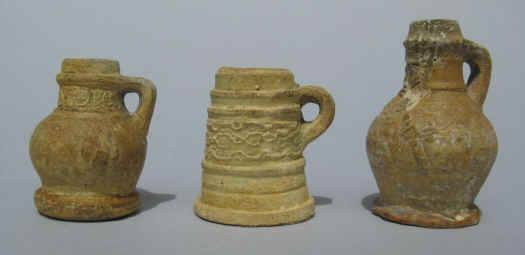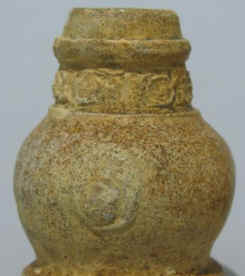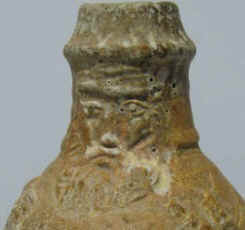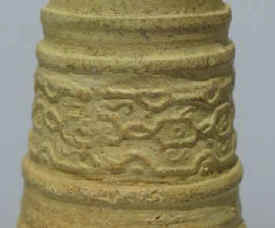
Imagine my elation when I unwrapped these little gems and saw how impressive they really were. They were tiny, the Bartmankrug is only 2” tall and the other two about 1 ½”. The detail was phenomenal ( see the close-ups below ) and they looked old — I mean, really old! They were unglazed but I felt that they had been fired at a pretty high temperature: they were “rugged”, not like “soft” pottery. They were not hollow like a container would be so they obviously were not intended to contain liquids. There were no marks anywhere. Upon studying them some more, I realized that they were not molded, but hand-thrown! How did the potter get such clear detail in the design? How did he make it? Did he have a tiny potter’s wheel? He must have had special tools just to make them. But what was their purpose???? Salesman’s samples? Models for new designs? What?
What I believe is the answer to the riddle came a few weeks later. I took them to someone I
hoped could give me some insight into their purpose and history. I met up with Gerd Kessler in
Colonial Williamsburg where he had been invited by the Foundation as a guest lecturer on
Westerwald Stoneware at a symposium on Early American pottery.
 As I unwrapped them, you could
see his eyes light up. He agreed that they were undoubtedly quite old (for him, meaning
before 1900) and was pretty sure what they were: they were toys, possibly from the early 1800s!
He also was impressed with the attention to detail in such tiny toys.
As I unwrapped them, you could
see his eyes light up. He agreed that they were undoubtedly quite old (for him, meaning
before 1900) and was pretty sure what they were: they were toys, possibly from the early 1800s!
He also was impressed with the attention to detail in such tiny toys.
When I questioned him about how he recognized them as toys, he responded that his Great Uncle in Hoehr-Grenzhausen had made stoneware toys and sold them in the late 1800s and early 1900s and these were quite similar.
You run across the most interesting, intriguing items sometimes.

